 |
Who can blame business technology executives if half a decade of overspending on IT now makes them somewhat obsessed by costs? Indeed, companies in much of the world are capping their IT expenditures. Some companies even peg the performance bonuses of chief information officers to how much money they cut from technology budgets.1
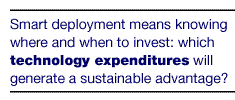 Yet companies underinvest in technology at their peril—even in lean times. New technology, deployed intelligently, can help organizations make dramatic leaps in productivity and redefine competition within whole sectors, as Wal-Mart and Dell Computer, among others, have shown. The essence of smart deployment is knowing where and when to invest. Which technology expenditures will yield a sustainable, differentiable advantage? Will the bleeding edge of technology bolster a company’s bid to be a leader, or should executives wait until the risks and costs fall? These perennially difficult questions—which hinge on a complex array of industry-specific factors—become even thornier when earnings pressures are high.
Yet companies underinvest in technology at their peril—even in lean times. New technology, deployed intelligently, can help organizations make dramatic leaps in productivity and redefine competition within whole sectors, as Wal-Mart and Dell Computer, among others, have shown. The essence of smart deployment is knowing where and when to invest. Which technology expenditures will yield a sustainable, differentiable advantage? Will the bleeding edge of technology bolster a company’s bid to be a leader, or should executives wait until the risks and costs fall? These perennially difficult questions—which hinge on a complex array of industry-specific factors—become even thornier when earnings pressures are high.
Compounding the challenge is the tendency to view technology, first, as a panacea and, then, after the hype proves unrealistic, as anathema. The experience of the leaders shows that new technology alone won’t boost productivity. Productivity gains come from managerial innovation: fundamental changes in the way companies deliver products or services. Companies generate innovations, in fat years or lean, by deploying new technology along with improved processes and capabilities.2
Priorities for investment
How can companies invest in technology to achieve meaningful gains? The McKinsey Global Institute (MGI) spent two years investigating the relationship between IT and productivity and found that the former most effectively stimulates the growth of the latter by helping companies to innovate. Innovation sometimes means creating new products (such as faster microprocessors), services (mobile telephony), or processes (on-line securities trading). But it also involves using technology to turbocharge existing processes by helping companies to extend their current advantages in key areas. When Wal-Mart linked IT with its efficient distribution network, it advanced both the state of the art in supply chain management and the productivity frontier of its sector.3
MGI’s research suggests that to foster innovation rather than merely spawn systems that are quickly imitated or promote the wrong goals, companies should focus on two priorities. The first is to identify the productivity levers offering the greatest opportunity for competitive differentiation: targeting the few specific levers that could well create a competitive advantage produces results more reliably than striving for improvement everywhere. The most promising IT initiatives usually evolve along with related business processes and build on an organization’s operational strengths. When taking this route, companies should beware the siren song of IT success stories from other industries, since the levers that matter in one sector may be irrelevant in another.
The second priority is to master the sequence and timing of investments. Many technology-based advantages, particularly those that don’t involve fundamental business changes, have a limited life because they diffuse rapidly through the sector. Timing is therefore critical if IT investments are to generate returns. Companies that get it right develop a clear understanding of how IT-enabled competition is evolving in their sectors. Investing ahead of the pack makes sense if the technology is hard to mimic, continues to yield benefits even if imitated, or offers great near-term value. Otherwise, companies can often hold down their spending and boost their returns by diving in only after others have made investments—and mistakes.
Responsibility for addressing these two priorities lies with technologists and business executives alike. An IT organization needs help to have a thorough understanding of the sources of a company’s productivity advantage and the competitive dynamics that influence the diffusion of technology. A smart approach to IT that emphasizes innovation, differentiation, and productivity thus requires senior executives to help set the technology agenda and be accountable for its results.
Innovation and diffusion
Our insights into the chemistry between effective IT investment and productivity build on earlier MGI research into the impressive US productivity gains achieved since 1995. Productivity, this study4 concluded, flourishes when competition becomes so intense that managers must innovate and competitors must adopt innovations quickly. Productivity boomed in the wholesale pharmaceutical sector, for example, when downstream retail consolidation squeezed wholesalers, forcing them to achieve major efficiencies by automating their warehouses.
 The rapid diffusion of technology may be good for economies, but companies derive the greatest advantage from innovations when competitors can’t adopt them quickly. Once many companies in a sector have implemented a set of IT applications, they become just another cost of doing business, not sources of competitive advantage. Naturally, competitors can most readily adopt the simplest IT-enabled improvements—those that primarily involve dropping a technology into place.
The rapid diffusion of technology may be good for economies, but companies derive the greatest advantage from innovations when competitors can’t adopt them quickly. Once many companies in a sector have implemented a set of IT applications, they become just another cost of doing business, not sources of competitive advantage. Naturally, competitors can most readily adopt the simplest IT-enabled improvements—those that primarily involve dropping a technology into place.
In retailing, for instance, central support systems, warehouse-management and -automation systems, and point-of-sale (POS) upgrades are now core IT investments that every large company makes. Although they do improve productivity for the whole sector, they confer no differentiating competitive advantage on individual companies; the benefits accrue to consumers, who enjoy lower prices and more convenient shopping. In the most extreme cases of rapid diffusion, competitors adopt similar technologies in a "me-too" investment frenzy; think of customer-relationship-management (CRM) and enterprise-resource-planning (ERP) software in the late 1990s.
But some technology initiatives either do generate new products, processes, and services or substantially extend a company’s existing advantages. Some of these innovations don’t diffuse rapidly, because embedded in them are barriers that reduce the competition’s ability to follow suit. Such barriers arise, for instance, when IT innovations are fused with broader changes in business processes or coupled with other, more sustainable advantages, such as economies of scale and scope or deep intellectual capital. Of course, the use of IT to generate innovations that enhance productivity and defy imitation poses important strategic questions. How, for example, should a company seek out investments that genuinely differentiate it from competitors? How can it plan the timing and level of investment to derive long-term value amid fierce competition?
Investing to differentiate
To find distinctive IT investments, companies should examine operational levers with the potential to affect productivity substantially (Exhibit 1). Each lever is distinct yet sufficiently broad to encompass a range of potentially valuable opportunities. Some levers are more critical than others; moreover, their importance can vary widely by sector and even by subsector or business model. Among the levers that matter, companies should determine which ones would yield a real competitive advantage if they served as the basis for new investments; often these levers evolve with and build on existing operational strengths. In a world of scarce IT resources, it is vital to know where—and where not—to target resources most intensively.
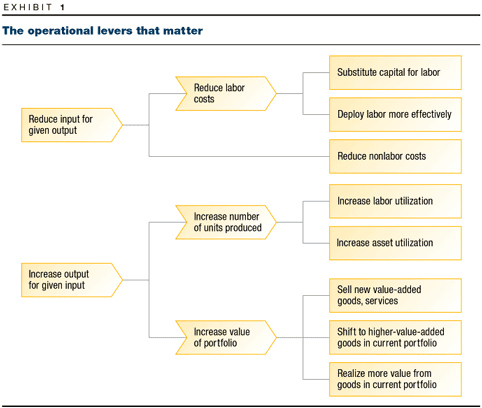
Indeed, some of the most impressive productivity gains come through a focus on a single lever. In the microprocessor subsector, for instance, major players, particularly Intel, have concentrated on new, higher-value goods, thereby generating extraordinary productivity advances as microprocessors and memory chips became exponentially more powerful though not exponentially more expensive. IT—for example, electronic-design-automation tools—played a vital role in helping manufacturers to design more complex chips and to make them more quickly, thereby powerfully underscoring the benefit of investments that target specific high-potential levers (Exhibit 2).
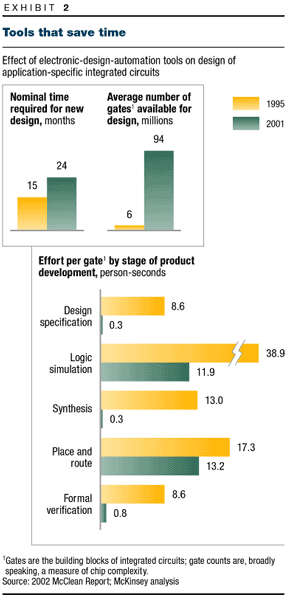
The trick, of course, is to target the right levers. During the 1990s, for instance, IT had its greatest impact on the retail-banking sector by helping to automate manual processes, on the retail home-improvement subsector by making employees more efficient, and on the dynamic-random-access-memory (DRAM) segment of the semiconductor sector by boosting output. IT systems aimed at other levers, such as the more effective deployment of labor in semiconductor fabrication facilities, had less impact even when implemented effectively.
Identifying the right levers requires an understanding, first, of the complex factors that drive the economics of individual companies and of the sector as a whole and, second, of the way IT can influence those key factors. The retail sector provides an example. Although Wal-Mart is the King Kong of general-merchandise retailers, slavishly emulating its approach to IT may be a losing strategy for retailers in other subsectors. General merchandising is characterized by low margins, large numbers of stock-keeping units, and high sales velocities—considerations that make it very important to cut the time goods spend sitting in warehouses. Sophisticated warehouse- and transport-management systems are thus absolute priorities for general merchandisers.
But the retailing of apparel is different. Premium merchants such as Neiman Marcus and Saks Fifth Avenue enjoy larger margins but must cope with the unpredictability of fashion trends and a seasonally changing assortment of goods. Of course, apparel retailers need efficient distribution, but some of their most promising opportunities involve the reduction of discounts. Industry experts suggest that apparel retailers sell 50 to 80 percent of their fashion items during the first four weeks of a new season. Discounting then sets in. Apparel retailers need both forecasting systems to predict demand and applications that help fine-tune these discounting campaigns. The bottom-line impact can be significant: one expert estimates that a good demand-forecasting system can increase the number of items sold at full price by more than 25 percent.
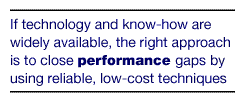 Companies are unlikely to match their sector’s leaders in all productivity levers, but shortfalls are no reason to invest heavily in every weak area. Instead, where technology and know-how are widely available, the right approach is to close performance gaps by using reliable, low-cost techniques such as implementing standard off-the-shelf applications or outsourcing business processes. When Wal-Mart, for example, acquired 122 Canadian Woolco stores, in 1994, it didn’t buy Woolco’s underperforming distribution assets, preferring to outsource warehouse management and transportation. Only by limiting any investment that doesn’t differentiate can companies hope to become truly distinctive in the areas that matter most for them.
Companies are unlikely to match their sector’s leaders in all productivity levers, but shortfalls are no reason to invest heavily in every weak area. Instead, where technology and know-how are widely available, the right approach is to close performance gaps by using reliable, low-cost techniques such as implementing standard off-the-shelf applications or outsourcing business processes. When Wal-Mart, for example, acquired 122 Canadian Woolco stores, in 1994, it didn’t buy Woolco’s underperforming distribution assets, preferring to outsource warehouse management and transportation. Only by limiting any investment that doesn’t differentiate can companies hope to become truly distinctive in the areas that matter most for them.
Conversely, intensive investment and even customization can make sense when they might produce lasting advantages. Wal-Mart originally achieved success in supply chain systems not by implementing standard software but by creating customized systems with the help of smaller vendors. This approach not only allowed the company to tailor the systems to its business needs rather than change its business processes to exploit the capabilities of the software but also made the systems and the processes they supported harder for competitors to duplicate. What is more, Wal-Mart didn’t create its own IT systems across the organization; it invested selectively. The key to success was its recognition that emerging technologies created a chance to build on existing operational strengths—particularly its highly efficient distribution network—by further optimizing sourcing and delivery.
The Wal-Mart story is far from unique. High-impact investments often evolve with and extend a company’s advantage. JPMorgan Chase, for example, recently used IT to augment its strengths in the automotive-finance market. The company already had more than 9,600 dealers in its system by early 2001 and was a leader in the prime-lending segment. It then began expanding its distribution network further: together with AmeriCredit and Wells Fargo, its LabMorgan subsidiary created DealerTrack, which permits dealers to help customers find and close loans on-line. DealerTrack’s automated car-finance origination and processing system is open to other banks. But since JPMorgan Chase’s scale makes it possible to offer low-cost loans in the prime-lending segment, the company continues to capture benefits as DealerTrack broadens its reach, today exceeding 18,000 dealers.
 Investments that pull a company’s key levers—particularly investments linked to scale and other operational strengths—should influence performance measurably. Although the impact of IT on a function can be hard to isolate, rough metrics are bound to exist if the business goals are clear. (An inability to determine in advance how to measure an investment’s business impact is a warning sign.) Inventory turns are an example of a rough but useful metric: when Wal-Mart bettered its performance from 6.6 in 1994 to 9.9 in 2001, the improvement showed that its RetailLink vendor-management system was on the right track. Kmart’s more modest improvement (to 5.9, from 4.7) over the same period reflected the difficulty of emulating IT capabilities that extend the sector leader’s existing operational advantages.
Investments that pull a company’s key levers—particularly investments linked to scale and other operational strengths—should influence performance measurably. Although the impact of IT on a function can be hard to isolate, rough metrics are bound to exist if the business goals are clear. (An inability to determine in advance how to measure an investment’s business impact is a warning sign.) Inventory turns are an example of a rough but useful metric: when Wal-Mart bettered its performance from 6.6 in 1994 to 9.9 in 2001, the improvement showed that its RetailLink vendor-management system was on the right track. Kmart’s more modest improvement (to 5.9, from 4.7) over the same period reflected the difficulty of emulating IT capabilities that extend the sector leader’s existing operational advantages.
Timing and sequencing
For companies competing on the basis of IT-enabled advances, knowing when to jump onto the innovation racetrack can be as important as how. Timing and sequencing, at their simplest, ensure that all prerequisite investments are in place before new IT initiatives are launched. Particularly in the retail sector, our research highlighted the importance of multiple tiers of investment, each laying the foundation for the next. In general merchandising, for example, before companies can implement sophisticated planning applications, a certain level of competence in warehouse- and transport-management systems is needed to get goods to customers.
Thus, companies that invest in sophisticated capabilities before the fundamentals are solid can easily waste money. One major general-merchandise retailer, for instance, invested millions to manage and measure the effectiveness of sales promotions, but since its warehousing systems couldn’t cope with the fluctuations in volume that accompany big promotions, it ended up with dissatisfied customers. Yet companies can also spend too much time and money on basic IT infrastructure and never reach the incremental high-return investments. Sequencing is a delicate balancing act.
Even with investments in place, companies must ask a strategic-timing question: should they lead or follow IT trends? There is a clear case for rapid action when an IT initiative is closely linked to business goals and truly innovates—either by contributing to new products, services, or processes or by improving existing processes to extend a company’s advantage. Similarly compelling are investments that continue to generate benefits even if imitated.
All these conditions existed when credit-fraud-detection capabilities emerged in the retail-banking industry, in the mid-1990s. The opportunity to reduce fraud losses resulted from a series of software breakthroughs, such as advanced neural networks and predictive transaction risk models, that created sophisticated new ways of tracking customer-behavior data.5 The magnitude of fraud losses not only justified experiments with the new software but also led managers to develop responsive new customer-contact processes to validate or reject suspicious transactions—an example of managerial and technical coevolution. The widespread adoption of the new systems didn’t diminish their impact on individual companies. By 2000, fraud losses for the whole sector had fallen to 0.18 percent of gross receivables, compared with 0.41 percent in 1994, and banks shared in the gains to the extent that they contributed to them.
The experience of JPMorgan Chase with DealerTrack shows how fruitful IT leadership can be when fused with other strengths. DealerTrack’s broad reach helps JPMorgan Chase serve dealers and customers more quickly. The result is a virtuous cycle of growth that extends the company’s enduring strengths.
By contrast, first movers have difficulty recouping the high cost of pioneering efforts when they are neither innovative nor hard to imitate. Restraint may make sense in these situations, but how can they be recognized? Consider another retail-banking initiative: CRM. Banks hoped that these new processes for gathering and disseminating customer information would help them increase their cross-selling rates, reduce the attrition of customers, attract new ones, and increase profitability per customer. Yet the process improvements inherent in CRM haven’t yielded the desired results: the number of products held by an average household at its primary bank has remained flat over the past three years despite massive spending (Exhibit 3). While some implementations have been difficult, an important reason for CRM’s tendency to produce little but customer churn is that many banks simultaneously launched similar initiatives in a slow-growing market. Banks that failed to make any CRM investments might have lost customers. Yet among the institutions that did invest, the pioneers have difficulty distinguishing their results from those of banks that followed.
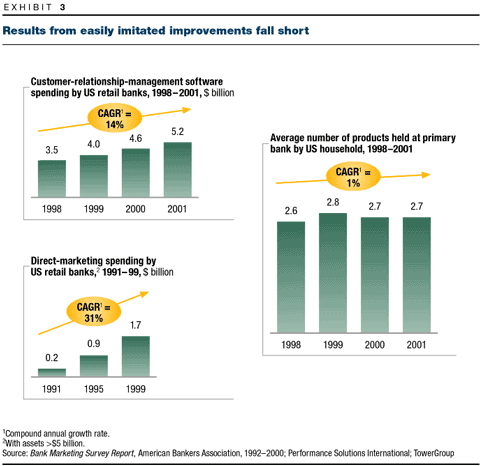
In fact, it can be challenging to tell beforehand whether an investment will yield innovative results. Two imperatives should guide companies making the difficult decision to pursue or yield leadership of a particular IT opportunity. The first is to look hard for signs that rapid diffusion is possible. In the case of CRM, the red flags included the sheer magnitude of the early hype, the large number of banks that consequently began implementations, and the emergence of a few software vendors with integrated product suites promising great future potential.
The second imperative is to recognize that the characteristics of a company can help it determine whether it is an appropriate leader in a given investment area. Having identified an opportunity for innovation, a company must ask itself how much appetite for risk it has in that part of the business, how confident it is that it can link the investment to other advantages and thereby stay ahead of the pack, and what sort of track record it has in putting people and processes in place to effect change. Where the answers are discouraging, the best option is usually to follow, not lead. Companies that foreswear low-cost follower strategies are squandering scarce resources that might be used more effectively to pull operational levers that could create a clear productivity advantage. After all, the goal is not to be the first to seize all IT-enabled productivity opportunities but rather to place smart bets on the right ones. Companies can improve their odds of success by evaluating themselves as well as their investments.
Smart IT investing doesn’t require a return to the spendthrift ways of the late 1990s. Companies that understand where to focus and how to time their efforts can find IT investments that will not only differentiate them from competitors but also provide a lasting competitive advantage—and avoid investments that won’t.
Notes:
*Diana Farrell is director of the McKinsey Global Institute; Terra Terwilliger is a consultant in McKinsey’s Silicon Valley office; Allen Webb is a consultant in the Pacific Northwest office.
This article is based on a collaborative study undertaken by the McKinsey Global Institute, McKinsey’s high-technology practice, and McKinsey’s Business Technology Office. Shyam Lal, James Manyika, Lenny Mendonca, Mike Nevens, and Roger Roberts helped lead the project. The research team, which deserves special recognition, included Anil Kale, Mukund Ramaratnam, Eva Rzepniewski, and Nick Santhanam.
1"Thrift shop," Information Week, December 23, 2002, pp. 18–9.
2See William W. Lewis, Vincent Palmade, Baudouin Regout, and Allen P. Webb, "What’s right with the US economy," The McKinsey Quarterly, 2002 Number 1, pp. 30–40; and Diana Farrell, Heino Fassbender, Thomas Kneip, Stephan Kriesel, and Eric Labaye, "Reviving French and German productivity," The McKinsey Quarterly, 2003 Number 1, pp. 40–55.
3MGI’s newest report—the basis of this article—is How IT Enables Productivity Growth, McKinsey Global Institute, Washington, DC, November 2002. It focuses on IT’s role in facilitating productivity gains in three high-performing US sectors during the 1990s: retailing, semiconductors, and retail banking.
4US Productivity Growth 1995–2000 (McKinsey Global Institute, Washington, DC, October 2001), which also emphasizes that regulatory changes can spur the competition that drives innovation.
5See Corey Booth and Shashi Buluswar, "The return of artificial intelligence," The McKinsey Quarterly, 2002 Number 4, pp. 98–105.
|
 |
 Yet companies underinvest in technology at their peril—even in lean times. New technology, deployed intelligently, can help organizations make dramatic leaps in productivity and redefine competition within whole sectors, as Wal-Mart and Dell Computer, among others, have shown. The essence of smart deployment is knowing where and when to invest. Which technology expenditures will yield a sustainable, differentiable advantage? Will the bleeding edge of technology bolster a company’s bid to be a leader, or should executives wait until the risks and costs fall? These perennially difficult questions—which hinge on a complex array of industry-specific factors—become even thornier when earnings pressures are high.
Yet companies underinvest in technology at their peril—even in lean times. New technology, deployed intelligently, can help organizations make dramatic leaps in productivity and redefine competition within whole sectors, as Wal-Mart and Dell Computer, among others, have shown. The essence of smart deployment is knowing where and when to invest. Which technology expenditures will yield a sustainable, differentiable advantage? Will the bleeding edge of technology bolster a company’s bid to be a leader, or should executives wait until the risks and costs fall? These perennially difficult questions—which hinge on a complex array of industry-specific factors—become even thornier when earnings pressures are high. The rapid diffusion of technology may be good for economies, but companies derive the greatest advantage from innovations when competitors can’t adopt them quickly. Once many companies in a sector have implemented a set of IT applications, they become just another cost of doing business, not sources of competitive advantage. Naturally, competitors can most readily adopt the simplest IT-enabled improvements—those that primarily involve dropping a technology into place.
The rapid diffusion of technology may be good for economies, but companies derive the greatest advantage from innovations when competitors can’t adopt them quickly. Once many companies in a sector have implemented a set of IT applications, they become just another cost of doing business, not sources of competitive advantage. Naturally, competitors can most readily adopt the simplest IT-enabled improvements—those that primarily involve dropping a technology into place.

 Companies are unlikely to match their sector’s leaders in all productivity levers, but shortfalls are no reason to invest heavily in every weak area. Instead, where technology and know-how are widely available, the right approach is to close performance gaps by using reliable, low-cost techniques such as implementing standard off-the-shelf applications or outsourcing business processes. When Wal-Mart, for example, acquired 122 Canadian Woolco stores, in 1994, it didn’t buy Woolco’s underperforming distribution assets, preferring to outsource warehouse management and transportation. Only by limiting any investment that doesn’t differentiate can companies hope to become truly distinctive in the areas that matter most for them.
Companies are unlikely to match their sector’s leaders in all productivity levers, but shortfalls are no reason to invest heavily in every weak area. Instead, where technology and know-how are widely available, the right approach is to close performance gaps by using reliable, low-cost techniques such as implementing standard off-the-shelf applications or outsourcing business processes. When Wal-Mart, for example, acquired 122 Canadian Woolco stores, in 1994, it didn’t buy Woolco’s underperforming distribution assets, preferring to outsource warehouse management and transportation. Only by limiting any investment that doesn’t differentiate can companies hope to become truly distinctive in the areas that matter most for them. Investments that pull a company’s key levers—particularly investments linked to scale and other operational strengths—should influence performance measurably. Although the impact of IT on a function can be hard to isolate, rough metrics are bound to exist if the business goals are clear. (An inability to determine in advance how to measure an investment’s business impact is a warning sign.) Inventory turns are an example of a rough but useful metric: when Wal-Mart bettered its performance from 6.6 in 1994 to 9.9 in 2001, the improvement showed that its RetailLink vendor-management system was on the right track. Kmart’s more modest improvement (to 5.9, from 4.7) over the same period reflected the difficulty of emulating IT capabilities that extend the sector leader’s existing operational advantages.
Investments that pull a company’s key levers—particularly investments linked to scale and other operational strengths—should influence performance measurably. Although the impact of IT on a function can be hard to isolate, rough metrics are bound to exist if the business goals are clear. (An inability to determine in advance how to measure an investment’s business impact is a warning sign.) Inventory turns are an example of a rough but useful metric: when Wal-Mart bettered its performance from 6.6 in 1994 to 9.9 in 2001, the improvement showed that its RetailLink vendor-management system was on the right track. Kmart’s more modest improvement (to 5.9, from 4.7) over the same period reflected the difficulty of emulating IT capabilities that extend the sector leader’s existing operational advantages.